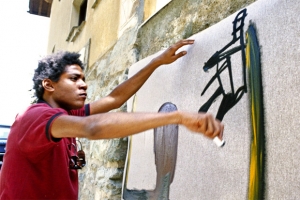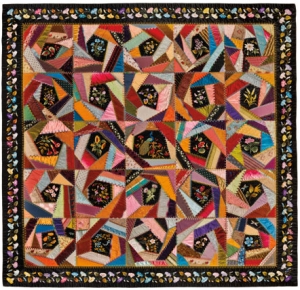|
Displaying items by tag: ephemera
Ernest Hemingway was a maker of lists and a collector of his life’s ephemera. For the first time, some of the objects that this American writer gathered during his long career — bullfighting stubs from Pamplona in Spain, boastful fishing logs from expeditions off the Cuban coast, coy letters to a mistress, penciled drafts of stories — will be on display in an exhibition at the Morgan Library & Museum from Sept. 25 through Jan. 31.
The University of California, Berkeley Art Museum and Pacific Film Archive has acquired the Steven Leiber collection of Conceptual art and ephemera as well as Leiber’s library of Conceptual art reference and artists’ books. Steven Leiber, who was a world-renowned dealer, scholar, and collector with a special interest in Conceptual art, died in 2012.
In recognition of Leiber’s impact on the history of art and on the museum’s own collection, BAM/PFA will name the area of its new building that will house these works “The Steven Leiber Conceptual Art Study Center.” BAM/PFA’s new building, designed by Diller Scofidio + Renfro, is currently under construction in downtown Berkeley and is slated to open in early 2016. With this new acquisition, BAM/PFA is poised to become one of the world’s leading centers for the study of Conceptual art.
The Eduardo Paolozzi Foundation has donated the artist’s private archive to Tate, the "Guardian" reported. The donation encompasses hundreds of boxes filled with drawings, collages, notebooks, and other ephemera and is one of the most significant archives given to the institution to date.
The material had filled the sculptor’s chaotic studio in London’s Chelsea until his death in 2005. Adrian Glew, the Tate’s archivist, said that Paolozzi’s belongings were stacked “almost floor to ceiling,” and consisted of “games, puzzles, TV circuitry, computer and transistor boards, optical instruments, piano keys, Lego, shoes, teeth, die, beads, bobbins, matches, chocolate molds, rubber stamps, playing cards, gramophone records, film and audio tapes.”

The Los Angeles County Museum of Art presents Expressionism in Germany and France: From Van Gogh to Kandinsky ( on view through September 14, 2014), an exhibition that sheds new light on the extraordinary response of artists in Germany and France to key developments in modern art in the early 20th century. For the first time in a major museum exhibition, Expressionism is presented not as a distinctly German style but as an international movement in which artists in Germany and France responded with various aesthetic approaches to modern masters such as Vincent van Gogh, Paul Cézanne, Henri Matisse, and Paul Gauguin, among others. Over 40 artists—including Wassily Kandinsky, Emil Nolde, Gabrielle Münter, Franz Marc, Robert Delaunay, and Pierre Bonnard—are represented in over 90 paintings and 45 works on paper, in addition to approximately 30 ephemera objects.
“Expressionism in Germany and France offers a unique opportunity to observe the ways that a generation of artists was influenced by some of the greatest names in modern art history,” says exhibition curator Timothy O. Benson. “Our visitors will gain insight into the culturally rich cosmopolitan milieu established by the many exhibitions, collectors, gallerists, critics, and not least the artists of the time (many of whom traveled between Paris and Germany) and how this cultural atmosphere transcended national borders.”

In 1979 when Jean-Michel Basquiat (1960-1988) was still an unknown graffiti artist, he shared an apartment with his girlfriend, Alexis Adler, in Manhattan’s East Village. Typical of his street art roots, Basquiat covered the space in murals, his signature scrawled crowns, and other artistic markings. The couple split up a year later, shortly before Basquiat rocketed to art stardom. Sadly, his life and career were cut tragically short by a drug overdose in 1988.
Adler, who now works as an embryologist at New York University, eventually purchased the apartment she once shared with Basquiat and never painted over his work. She also held on to the artist’s notebooks, postcards, painted clothes, photographs, and drawings. After three decades, Adler has begun consulting with advisors in regard to her unparalleled collection of Basquiat ephemera. It has been rumored that she is looking to release a book on her never-before-seen collection, which could entail an exhibition and sale, but has not been confirmed by Adler.
After his death, Basquiat remained a major figure in the art market and he continues to be the subject of highly anticipated exhibitions. Adler’s holdings will no doubt be a welcomed addition to the Basquiat market presence. In an attempt to ready herself for the frenzy that will undoubtedly ensue, Adler has hired Stephen Torton, Basquiat’s former assistant, to represent her in any future sales. Lisa Rosen of Fine Art Restoration is responsible for refurbishing and removing a wall from the apartment that contains a full Basquiat mural and Sur Rodney Sur, the former director of the Gracie Mansion gallery, has already catalogued the 65-plus items in the collection.
Also included in Adler’s remarkable collection is a script for a play written by Basquiat and rolls of 35mm film documenting the artist at work as well as candidly going about his day. The collection offers a rare glimpse of the artist on the brink of unprecedented fame.

The Brooklyn Museum, which holds a celebrated decorative arts collection, is currently presenting a selection of rarely seen American and European quilts. In fact, only one of the 30-plus quilts on display has been on public view in the past 30 years.
The exhibition titled Workt by Hand: Hidden Labor and Historical Quilts aims to explore the impact of feminist scholarship on the ways in which historical quilts have been and are currently viewed, contextualized, and interpreted. The exhibition goes beyond the connection of quilting to feminism and explores the medium of quilting as an art form and as an aspect of material culture with meaningful social and political undertones.
The quilts on view at the Brooklyn Museum span two centuries and feature iconic designs and techniques including the log cabin style, the Amish sunshine and shadow style, and crazy quilts, which were fashionable during the late 19th century. A quilt by Mary A. Stinson that is considered one of finest examples of a crazy quilt is included in Workt by Hand.
Workt by Hand aims to shed light on the skill, craftsmanship, thought, and energy that went into quilting; something that was frequently overlooked in a male-dominated society. The exhibition, which is on view through September 15, 2013, includes photographs, newspaper clippings, sample pieces of quilts, and other ephemera relating to the history of quilts.
|
|
|
|
|